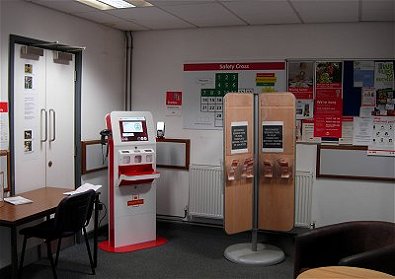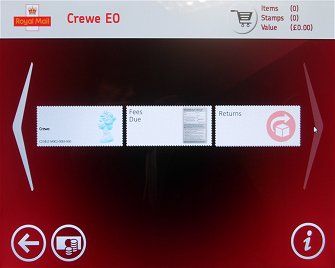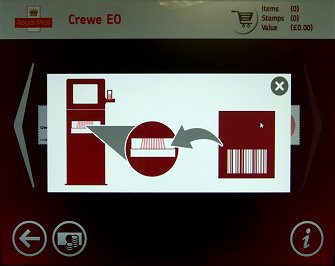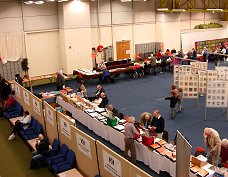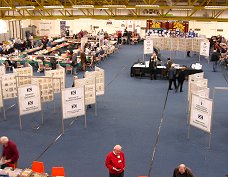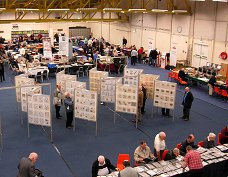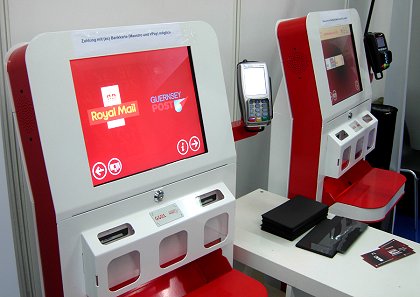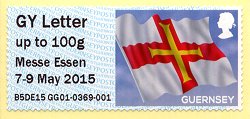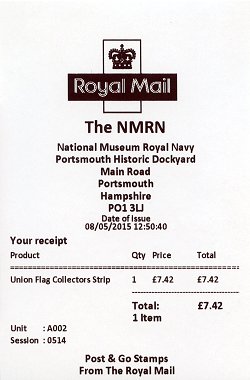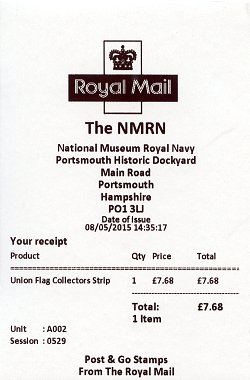| UNITED KINGDOM. 2015, the Post&Go issues (7) |
|
 |
| The postal kiosk at The Royal Marines Museum |
Following the experiences at The British Postal Museum & Archive, (see article, also published in VARIABLE 27) but mostly at The National Museum of the Royal Navy in Portsmouth, (see article, and VARIABLE 34), Royal Mail decided to install the third permanent postal kiosk in The Royal Marines Museum.
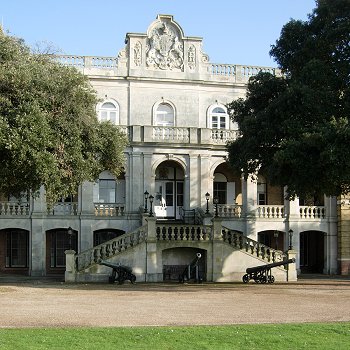 |
The Royal Marines Museum is a small museum, created in 1958, which displays the history of the Royal Marines, the United Kingdom's amphibious light infantry force, since its beginnings in 1664, up to the present day. |
| The museum is located in Southsea, a suburb south of Portsmouth. It is housed in the former headquarters of the Royal Marine Artillery, built in the mid-nineteenth century. |
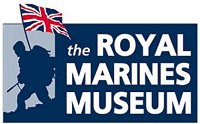 |
Since 2011, The Royal Marines Museum has been part of The National Museum of the Royal Navy, a group of four Royal Navy museums which also includes the Portsmouth museum. Two of these museums already have a permanent kiosk. Therefore, it would not be surprising that other kiosks could be installed soon in the other two museums, the Royal Navy Submarine Museum in Gosport and the Fleet Air Arm Museum, in Yeovilton.
The Intelligent AR postal kiosk was put into operation on January 13th 2015, in the small museum shop (pictured). It is kiosk A005, first introduced at the London Spring Stampex 2014 (see article, and VARIABLE 32).
Being a permanent location, Royal Mail decided to include the special imprint or identifier 'The RMM' (The Royal Marines Museum) on all the stamps issued by the machine. |
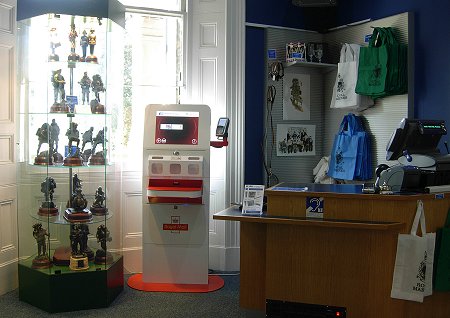 |
| The postal kiosk can issue ATMs with the two current definitive designs, 'Machin' and 'Union flag'. From the date of installation until the latest revision of this article, the machine used rolls of the 'Machin' design, in the original release and the 2013 reprinting (MA13), and 'Union flag', in the original edition. |
 |
 |
 |
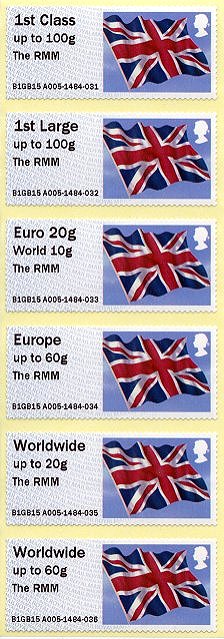 |
Neither the features of the museum, with a small shop and a reduced number of visitors (with an average of 29,000 per year), nor the kiosk features and its issues, justify the installation of postal equipment at this location. In fact, as in the case of the neighbouring Portsmouth museum, there is no letter box in the shop, and during our visit, none of the museum staff knew the location of a nearby letter box. Again, this is a kiosk designed and installed for philatelic purposes only, and whose survival and profitability is subject to the occasional label design changes and / or the creation of special temporary imprints that may attract the attention and interest of collectors. |
| The trial with postal kiosks in the Enquiry Offices |
From early December 2014 to late January 2015, Royal Mail installed two Intelligent AR postal kiosks in the Crewe and Bradford North Enquiry Offices, as additional sources for stamp sales over the holiday period (see article, published in VARIABLE 35). After this experience, Royal Mail decided to extend the trial for a minimum of six months, by replacing the two machines, A003 and A004, which were to be used, in mid-February, at the London Spring Stampex, with two new postal kiosks, numbered M002 and M003.
Crewe is an industrial town located in the northwest of the country, in the county of Cheshire. The Royal Mail Enquiry Office is located in a commercial estate to the east of the city, near the train station.
The Enquiry Office is a postal facility where users can collect undelivered items of mail. Some of the offices, such as Crewe, sell stamps, although they are not post offices. |
 |
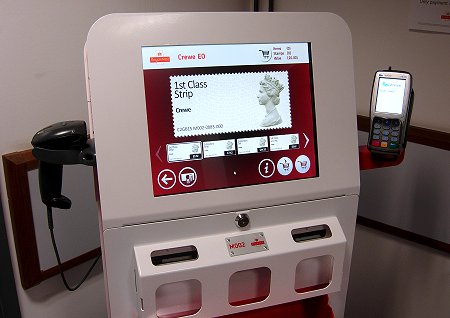 |
The new postal kiosk M002 (images) was installed on February 9th 2015. On that date, the machine could issue priority or '1st Class' and economic domestic or '2nd Class' stamps, printed on rolls of labels with the corresponding definitive Machin design (images below).
In addition to the machine code printed on the stamps, Royal Mail also decided to include the name of the office -Crewe- under the face value indicator. |
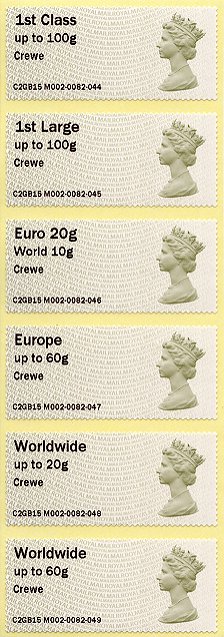 |
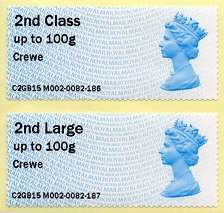 |
1st Class & 2nd Class Collectors strips |
| As shown in the strips, the code printed at the bottom of all the stamps has two important changes, from the collecting point of view. |
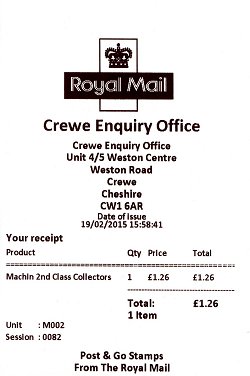 |
Unlike stamps issued by 'philatelic' kiosks, whose code starts with 'B', the code of the stamps issued by these new postal kiosks begins with 'C'. In addition, the identifier of the machines installed in the Enquiry Offices begins with 'M' (Mail kiosk). |
C2GB15 M002-0082-044
C (Postal kiosk / issue), 2 (month of issue - February), GB (country of issue - United Kingdom), 15 (year of issue).
M002 (postal kiosk identifier) - 0082 (session number) - 044 (stamp number). |
Apart from the sale of stamps, these kiosks offer a new postal service - the 'Returns' option, for the return of mail items (screens below). The user scans the return label by using the barcode readers in the bottom tray or the external one on the left side of the machine, and then the machine prints a receipt.
| The 'Fees Due' option allows for the payment of customs duties ('Customs Due') or insufficient postage ('Postage Due'). In this case, the user must specify the rate to be paid, (usually the lack of postage) plus a surcharge of 1 GBP and, after payment, the machine issues a receipt for the total (right). |
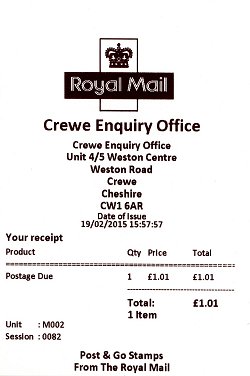 |
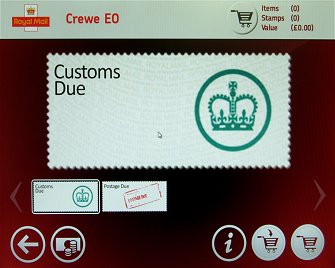 |
 |
The second kiosk was installed in one of the two Royal Mail postal units in Bradford, a city of 300,000 inhabitants, located in the centre of the country, in the county of Yorkshire.
Bradford North is a newly refurbished office, also located in a shopping and services area to the north of the city, with an easy access by car and extended opening hours. |
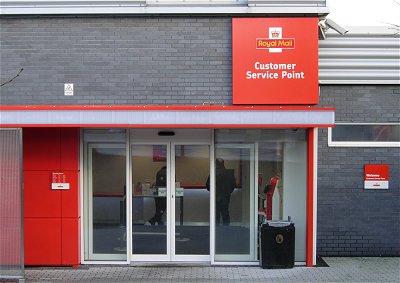 |
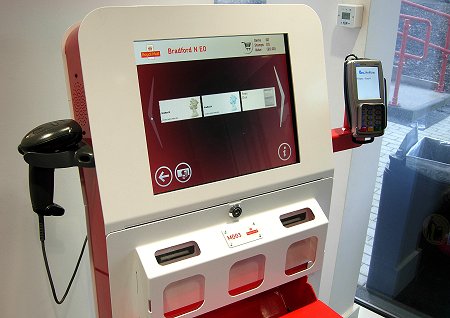 |
The postal kiosk, with the M003 code, was also installed on February 9th 2015. It has the same features and utilities as M002, and issues the same type of stamps as the equipment installed in Crewe.
In this case, the kiosk prints the identifier 'Bradford N' under the face value indicator. |
 |
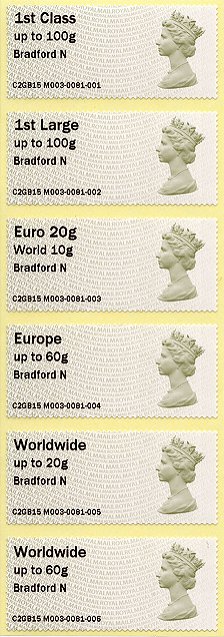 |
 |
1st Class & 2nd Class Collectors Strips |
 |
On the date of installation, the stamps sales menu in both postal kiosks offered the same options as the other kiosks, originally designed for philatelic use. Indeed, in view of the session numbers (identical on both machines), it appears that during the first weeks they have only has been used to issue stamps for collection. However, Intelligent AR is developing new software, new functions and utilities, such as the inclusion of a weighing unit, which would improve user experience. |
As a result of feedback from customers, Royal Mail decided to remove the location identifiers ('Crewe' & 'Bradford N') printed under the face value indicators. This change was carried out on March 30th 2015, at the same time as the change of postal tariffs and face value indicators.
| The ATMs at SPRING STAMPEX 2015 |
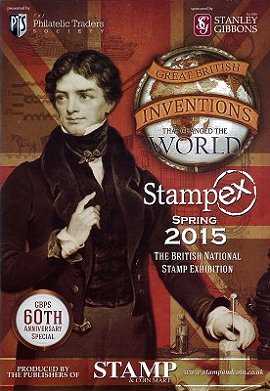 |
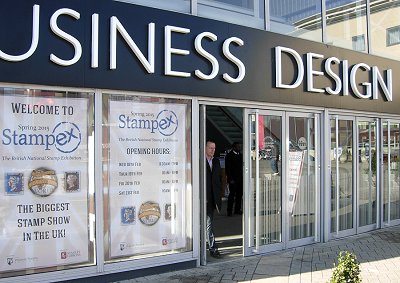 |
| Just three months before Europhilex 2015, the biggest philatelic show of the year in Europe, the spring event of the biannual London Stampex was held from Wednesday 18th to Saturday 21st of February 2015, at its usual location, the Islington Business Design Centre. |
| (For more information, see articles on the two last Stampex fairs, the Spring Stampex 2014, also published in VARIABLE 32, and the Autumn Stampex 2014, in VARIABLE 34). |
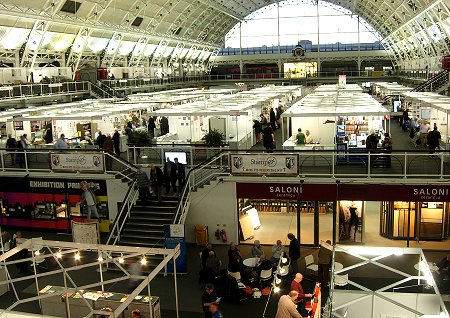 |
During Spring Stampex 2015, the Great Britain Philatelic Society (GBPS) celebrated its sixtieth anniversary, with meetings and a competitive philatelic display, as well as a special edition of the exhibition catalogue.
Royal Mail positioned the 'Post & Go Services' in an independent stand, at the entrance level and installed four Intelligent AR philatelic kiosks. New for Spring Stampex 2015 was Guernsey Post which joined the 'Post & Go' family with a new kiosk (more details in the article, also published in VARIABLE 36).
In the picture, from left to right are the A003 and A004 kiosks from Royal Mail, the printer for personalized stamps or 'Smilers', the new GG01 kiosk from Guernsey Post, and the Jersey Post JE01 equipment.
In addition, a fifth Intelligent AR kiosk was installed in the large Royal Mail stand, at the back of the exhibition hall. It was the new A006 kiosk, in service for the first time during Stampex (image below, right). Visitors could use the kiosk not only to purchase the 'Post & Go' issues, but also to buy presentation packs and any other product on sale having a barcode. |
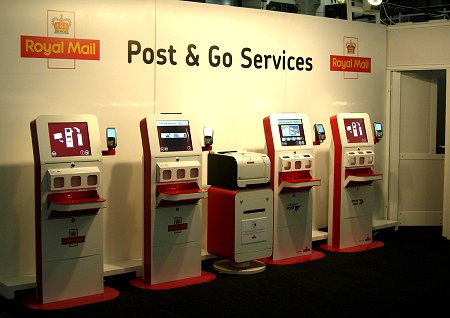 |
 |
 |
| During the four days of Spring Stampex 2015, the Royal Mail A003 and A006 kiosks issued ATMs with the Machin definitive design (2013 reprinting - ROYALMA13) on one of the reels, and the new 'Working sail' series in the other (see next section). |
 |
 |
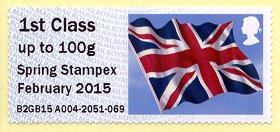 |
The A004 kiosk issued stamps with the Union flag definitive design (original printing) and the special imprint
Spring Stampex
February 2015
and the new 'Working sail' series. |
| The GG01 kiosk of Guernsey Post issued the new Guernsey flag definitive design on one of the reels, and the UK Union flag design from the other printer. This latter design had the special imprint 'Spring Stampex February 2015'. All stamps issued by the machine during Spring Stampex were sold with a 20% surcharge on the face value, because of the VAT on sales made by Guernsey Post in the UK. |
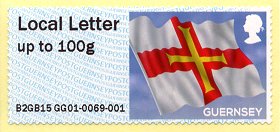 |
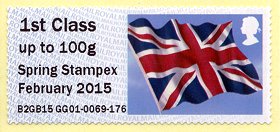 |
 |
The Guernsey philatelic service sold six-value sets, or 'Collectors strips', with the new design and the special imprint
Spring Stampex
February 2015
printed by the internal use equipment B002. |
| The Guernsey flag design is dealt with in more detail in the article dedicated to the new 'Post & Go' issues of this postal administration. |
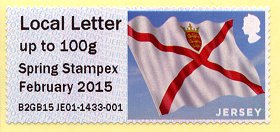 |
After a year using rolls with the UK Union flag design in one of the printers, the Jersey Post JE01 kiosk only issued stamps of this postal administration - the Jersey flag definitive design with the special imprint 'Spring Stampex February 2015' and the new 'Protected species' set. |
| Just like the Guernsey kiosk, the stamps issued by the Jersey equipment were also sold with a 20% surcharge on the face value. |
| These issues are dealt with in more detail in the article dedicated to Jersey Post. |
In addition to these machines, large pre-orders were printed by using the internal use printers B001 (UK designs) and B002 (Guernsey and Jersey Post designs).
| Gibraltar, Guernsey, Isle of Man and Jersey philatelic services
shared a small stand at Spring Stampex 2015. It is most likely that, very soon, the Royal Mail 'Post & Go' stand will be too small for all the kiosks of the new postal administrations joining the 'Post & Go' project. |
 |
 |
In 2015, Royal Mail has planned to release four 'Post & Go' thematic sets. Unlike previous years, only two of the sets have a link to the theme, the ‘Working Sail’ and ‘Sea Travel’ series, released at the two Stampex. The other two sets will be dedicated to ‘Heraldic Beasts’, and are scheduled for Europhilex, whilst the ‘Winter Fur and Feathers’, will be released at the end of the year.
The first set was available from February 18th 2015, coinciding with the opening of Spring Stampex 2015. The series featured six British sailing ships, from paintings by the artists known as Pierhead painters, dated in the late nineteenth and early twentieth centuries.
On the issue date, the new series could be obtained at many of the NCR postal kiosks installed in post offices across the country, and also from the Intelligent AR postal kiosks (A003, A004 & A006), installed at the London Stampex. The pre-orders were printed using internal-use equipment, with the code B001.
Royal Mail released its usual presentation pack with the six designs (right image), printed by the internal-use C002 printer. |
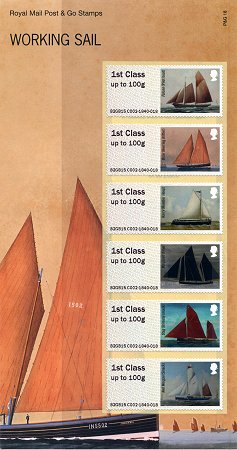 |
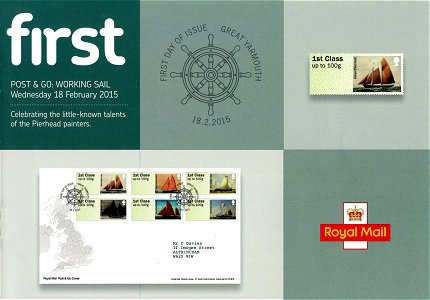 |
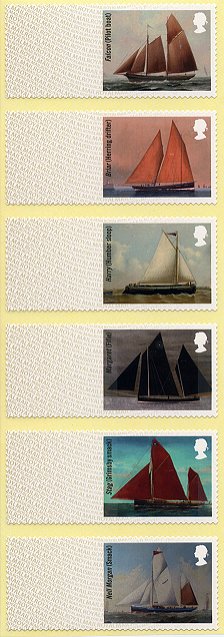 |
The six paintings feature the ships 'Falcon', painted by John William Green in 1897, 'Briar', by Alexander Harwood (1907), 'Harry', by Reuben Chappell, 'Margaret' by Henry Lawson (1890), 'Stag' by George Race, and 'Nell Morgan' by G Ramsey (1886).
The rolls of labels were manufactured by International Security Printers, and have identical characteristics to previous issues. The design is by Osborne Ross. |
| |
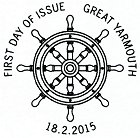 |
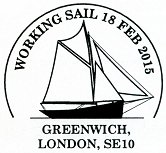 |
| |
 |
 |
| Pictorial first day of issue postmarks |
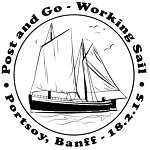 |
 |
The images below show ATM strips with the different printing varieties and the six face value indicators available for this set of designs, issued by the different equipment used on the date of issue.
From left to right,
(1)
the C002 printer, used for advance printing of the stamps included in the folders or presentation packs,
(2) the Intelligent AR equipment (A003, A004 & A006), in service at Spring Stampex, and for internal use (B001),
(3) the NCR postal kiosks.
This set was not available from any of the very few Wincor Nixdorf postal kiosks still in service, on the date of issue.
All the ATMs included in the folders have the same face value '1st Class up to 100g', and the lower identification code is the same for all the stamps - In this case, B2GB15 C002-1840-018. In the first block, B is for 'philatelic' issue, 2 is for the month of issue (February), GB for the country, and 15 for the year of issue. In the second block, C002 is the code of the printer. Then follows 1840, the usual fictitious session number (using the year of issue of the Penny Black), and 018 indicates the number of the pictorial series, since the beginning of the Post & Go issues. |
 |
| First day of issue receipt for the purchase of one 'Collectors strip', the set with the six values programmed, in the A003 Intelligent AR postal kiosk installed at Spring Stampex |
Printer
C002 |
Intelligent AR
A003 - A004 - A006 - B001 |
NCR
postal kiosks |
 |
 |
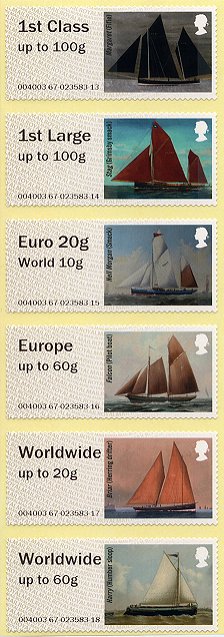 |
| The 'Open value stamps' can be obtained from the NCR postal kiosks only, by selecting the 'Post an item' option from the main menu. These are variable value stamps, usually printed for immediate franking, and includes some details about the shipment type, postage rate, destination and weight of the item (see article, also published in VARIABLE 34). The six 'open value stamps' on the images correspond to the six face value indicators programmed in the 'Collectors strip'. |
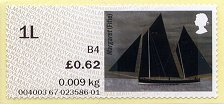 |
 |
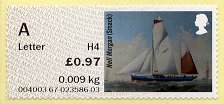 |
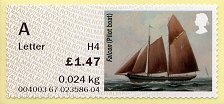 |
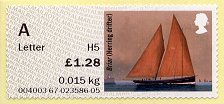 |
 |
| First day cover with the six designs, and the Spring Stampex 2015 special first day postmark |
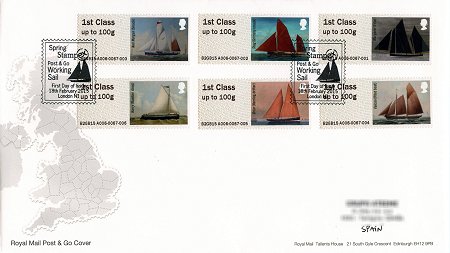 |
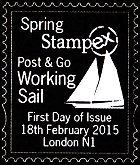 |
| Anthony Trollope at The British Postal Museum & Archive |
| In 2015, The British Postal Museum & Archive (BPMA) celebrates the bicentenary of Anthony Trollope's birth. Perhaps unknown to most non-British readers of this article, Trollope was the most successful British novelist of the Victorian era, who also worked for over 30 years at the General Post Office, the organisation responsible for British postal and telecommunications administration. After the major reform of the postal service in the first half of the nineteenth century, Trollope proposed the installation of cast iron mailboxes, shaped like a pillar, on selected streets, and to invite the public to deposit their letters safely. The first four pillar boxes were installed in Jersey, in November 1852, and another six followed in February 1853, in Guernsey. In the same year, the first pillar boxes were installed in the UK. |
 |
In a new chapter of an interesting tour of the British postal history, through the 'Post & Go' issues, The British Postal Museum & Archive programmed its philatelic kiosk with a new commemorative imprint
The B.P.M.A.
Trollope 200
Taking advantage of the machine’s capabilities, a new graphic design featuring one of these first pillar boxes was also included.
The temporary special imprint could be obtained from February 18th 2015, which coincided with the opening of Spring Stampex 2015, and will be available until April 30th. |
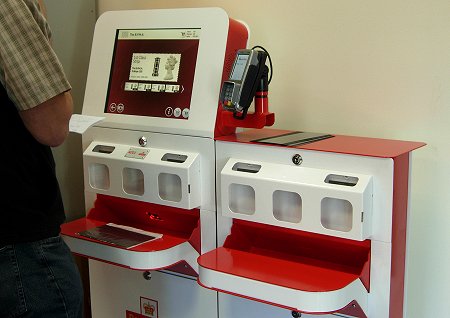 |
| To mark this anniversary, the postal museum organized different activities and an exhibition. In the small lobby of the museum, with the kiosk shifted to the right of the entrance (the third position from the installation of the first machine, in December 2012), this special issue included a commemorative panel and one of the pillar boxes, built by John Vaudin and installed in Guernsey in 1853 (right image). Originally, these postboxes were known as 'assistant post offices'. |
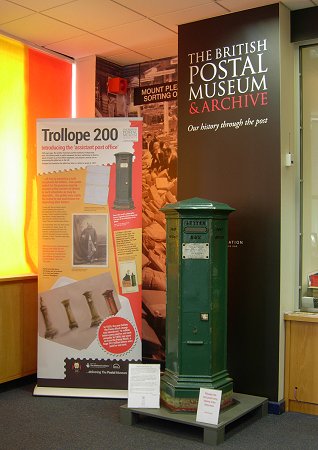 |
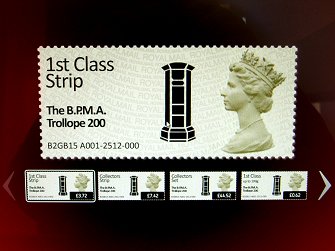 |
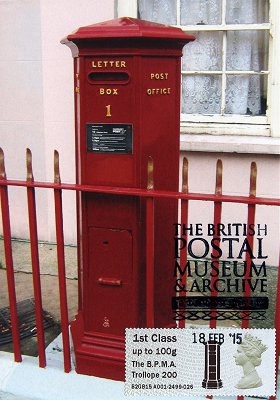 |
Only two of the 'Vaudin' postboxes have been preserved to this day. One is still in service in its original location, on Union Street, St. Peter Port, Guernsey (left maximum card and cover below), and the other, painted in green, is part of The British Postal Museum & Archive collection, in London (right). |
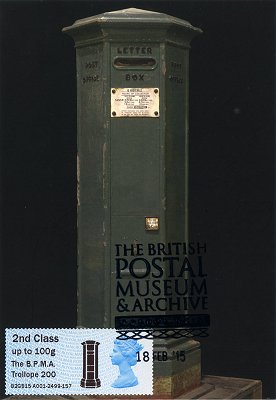 |
 |
In 2002, Guernsey Post commemorated the 150th anniversary of the pillar boxes with a special issue and an illustrated first day cover featuring the picture of Anthony Trollope and the only pillar box still in service. |
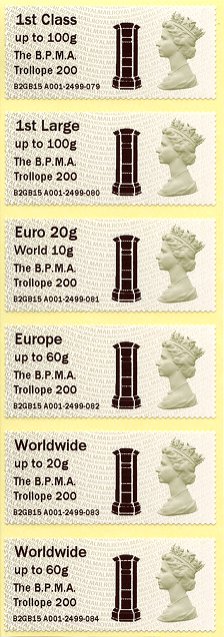 |
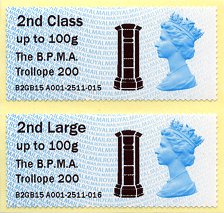 |
On the date of issue, the kiosk used three different rolls of labels and therefore could issue ATMs with the three UK definitive 'Post & Go' designs. The special imprint was 'only' available with the two Machin designs, on rolls of the 2013 reprinting (MA13) for the priority mail '1st Class' stamps, and with the blue 2012 reprinting (MA12) for the economic mail or '2nd Class' stamps. |
| The set or Collector strip for priority mail consists of six different face value indicators, while only two domestic values are available for economy mail - '2nd Class up to 100g' & '2nd Large up to 100g'. |
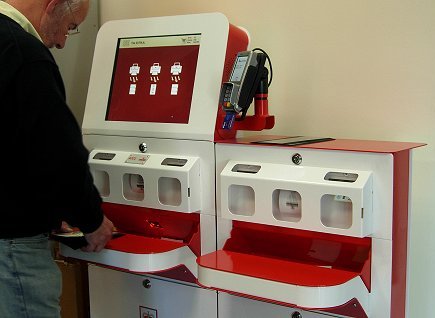 |
| The museum sold a special presentation pack, containing both collectors strips and a postcard, and an illustrated first day cover with two stamps (right image). These covers, with a limited printing of 200, were quickly sold out - The '1st Class' ATM was printed by using a roll of the original Machin edition, and not the 2013 reprinting available at the kiosk (...). |
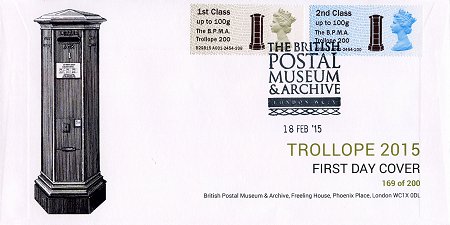 |
| March 2015, changes in postal rates and face value indicators |
On March 30th 2015, exactly one year after the last change of postal rates, Royal Mail again increased some prices and simplified the rates with the removal of another weight step. The six weight steps established before March 2014 for international standard letters up to 100g, (10, 20, 40, 60, 80 & 100 g), were reduced to four from March 31st 2014 (10, 20, 60 & 100 g), and to three from March 30th 2015 (10, 20 & 100 g).
This involved the change of two of the six postage rates programmed into the 'Post & Go' kiosks. The values 'Europe up to 60g' & 'Worldwide up to 60g', in force for only one year, were replaced by 'Europe up to 100g' & 'Worldwide up to 100g', respectively.
| Old indicators |
Postal rates |
New indicators since
March 30th 2015 |
| 1st Class up to 100g |
62p |
63p |
1st Class up to 100g |
| 1st Large up to 100g |
93p |
95p |
1st Large up to 100g |
| Euro 20g World 10g |
97p |
£1.00 |
Euro 20g World 10g |
| Europe up to 60g |
£1.47 |
£1.52 |
Europe up to 100g |
| Worldwide up to 20g |
£1.28 |
£1.33 |
Worldwide up to 20g |
| Worldwide up to 60g |
£2.15 |
£2.25 |
Worldwide up to 100g |
| |
£7.42 |
£7.68 |
|
| The postal kiosk at The Fleet Air Arm Museum |
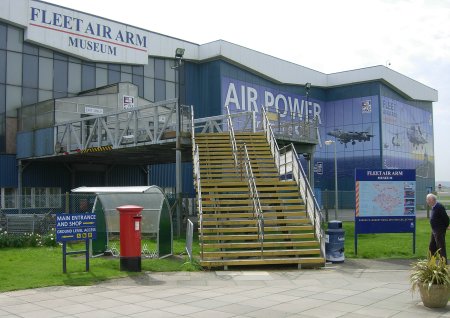 |
Three months after the installation of the postal kiosk at The Royal Marines Museum (see article, also published in VARIABLE 36), Royal Mail decided to install the fourth permanent kiosk in another of the museums that form part of The National Museum of the Royal Navy, the Fleet Air Arm Museum.
The Fleet Air Arm Museum is located at the Yeovilton military airfield (Royal Naval Air Station Yeovilton or RNAS Yeovilton), in Ilchester, Somerset, about 200 km. west of London. |
 |
 |
The museum was created in 1964 and is devoted to the the history of British naval aviation. Today, the museum consists of four large halls, displaying a collection of over 90 aircraft, models of aircrafts and ships, as well as paintings, drawings and other documents and objects related to naval aviation.
With an average of 110,000 visitors per year, it is the largest museum of naval aviation in Europe, and the second worldwide. |
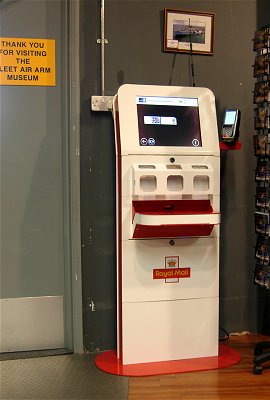 |
The Intelligent AR postal kiosk was put into operation on April 14th 2015, next to the exit of the museum shop (pictures).
It is kiosk A003, first introduced at the London Spring Stampex 2014 (see article, and VARIABLE 32) and subsequently used, temporarily, in the Enquiry Office of Crewe and several philatelic events. |
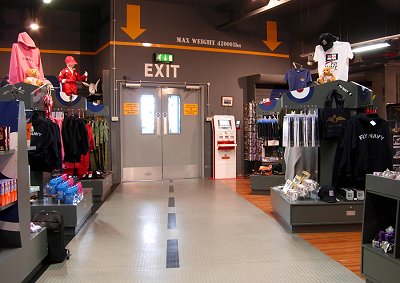 |
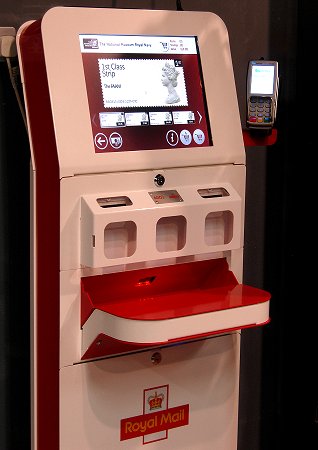 |
On the first day in service, the kiosk used the stamps on rolls of the two current definitive designs, the 'Machin' (2013 reprint - MA13) and the 'Union flag', in the original edition. |
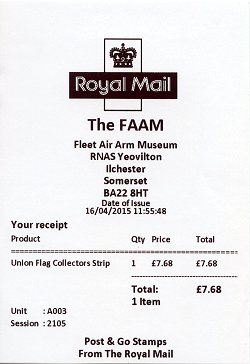 |
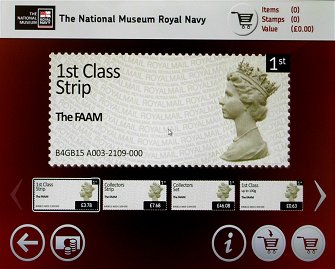 |
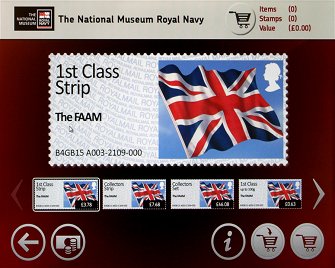 |
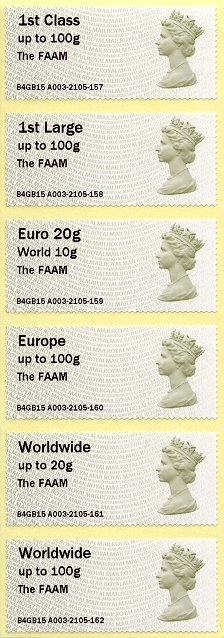 |
 |
Like the other permanent kiosks installed in museums, Royal Mail decided to include a special imprint or identifier on all stamps issued by the machine. In this case, 'The FAAM' (The Fleet Air Arm Museum). Royal Mail also planned to include a graphic design with the museum logo, but because of a technical problem with the connection, the introduction of the graphic was finally delayed.
Like other Intelligent AR kiosks, this is a machine with great potential. However, because its current features will be rarely used by museum visitors, and its survival and profitability are again subject to its philatelic usage. There will be two special temporary imprints planned during the year. For collectors, it has a special disadvantage because of its location. It is very difficult to reach by public transport, and is far from London and the other equipment installed in the Portsmouth area. |
| The 86th Scottish Congress, in Perth |
Following the success at Autumn Stampex 2012, Royal Mail decided to promote its 'Post & Go' equipment at some major national philatelic events outside London. The first trip for the machines was to the 94th Philatelic Congress of Great Britain, held in Perth, Scotland, in October 2012 (see article, also published in VARIABLE 27). Every year since then, Royal Mail has installed its 'Post & Go Services' in this remote town, north of Edinburgh, on the occasion of the annual Congress of the Association of Philatelic Societies of Scotland.
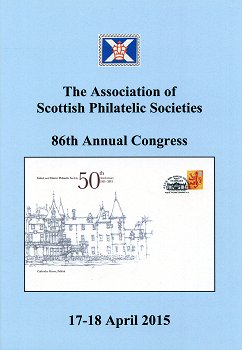 |
In 2015, the 86th Congress was held on Friday April 17th and Saturday 18th, in its usual location at the Dewar's Centre, in Perth (images). |
This major philatelic event is organized, each year, by one of the Scottish societies. In 2015, the annual meeting was hosted by the Falkirk & District Philatelic Society, which celebrated its 50th anniversary.
In addition to the congress, the event included a philatelic & postcard exhibition and an important fair, attracting many national collectors. |
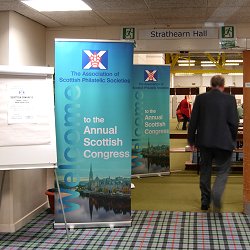 |
On this fourth visit of the 'Post & Go' equipment to Perth, Royal Mail used the same equipment as in 2014. The printer for 'Smilers' or personalized stamps (on the far left of the image), and three Intelligent AR postal kiosks - two Royal Mail kiosks (A006 and A008), and the 'traveller' kiosk of Jersey Post (JE01).
While machine A006 had already been used at the London Spring Stampex 2015, the kiosk A008 was used, for the first time, in Perth.
(See articles dedicated to Perth 2012, also published in VARIABLE 27, Perth 2013, in VARIABLE 29, and Perth 2014, in VARIABLE 33). |
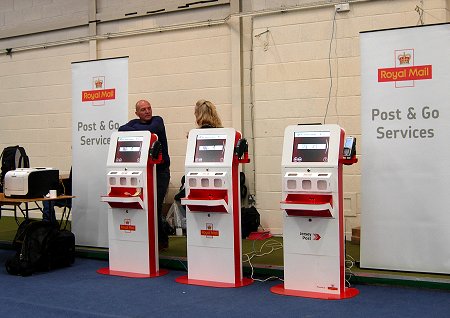 |
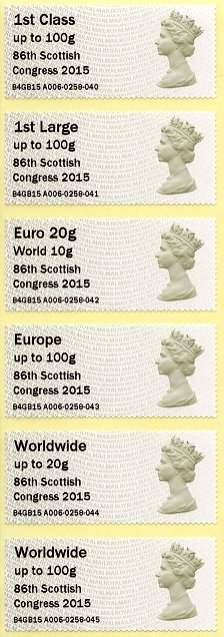 |
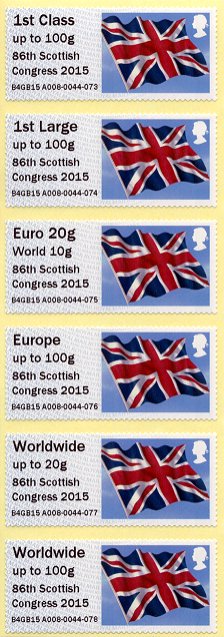 |
As on previous occasions, Royal Mail decided to programme a special text into its postal kiosks. Over the two days, machines A006 and A008 issued stamps with the definitive issues 'Machin' (original design and the 2013 reprint - MA13), and 'Union flag' (original design), and the special imprint
86th Scottish
Congress 2015
The code at the bottom of the stamps, issued during this philatelic event, is B4GB15 A006- and B4GB15 A008-.
ATMs were also printed using the B001 internal printer, to meet the demands of collectors and dealers who were not able to travel to Perth. |
Unfortunately, because of a programming error, all the ATMs issued by B001 machine and printed prior to the congress, include a different special text, without the year at the end
86th Scottish
Congress |
And another error. During the morning of the first day, the new kiosk A008 issued receipts with an error in the heading,'85th Scottish Congress' instead of the correct '86th Scottish Congress'. |
 |
 |
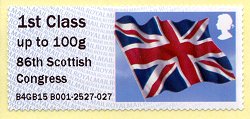 |
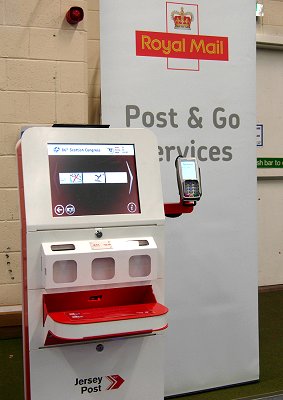 |
From the JE01 postal kiosk of Jersey Post, visitors could obtain the definitive issue 'Jersey flag' with the special imprint '86th Scottish Congress 2015', and also the series 'Protected species' with no special text. The code at the bottom of all the stamps issued at Perth is B4GB15 JE01-.
(These issues are dealt with in more detail in the article dedicated to Jersey Post). |
| And again, because of a programming error, all the ATMs sold by Jersey Post and printed by the B002 machine, do not include the year at the end of the special text. This error also appeared in the first stamps issued by the JE01 kiosk installed in Perth. |
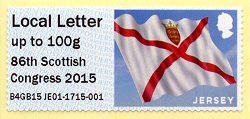 |
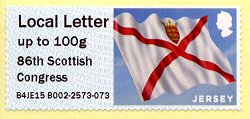 |
| The Falkirk & District Philatelic Society produced a commemorative cover, and designed the Congress postmark. Both designs depict the Callendar House, located in Falkirk. This mansion dates from the 14th century, and it is currently used as a museum with exhibitions on the history of Falkirk. |
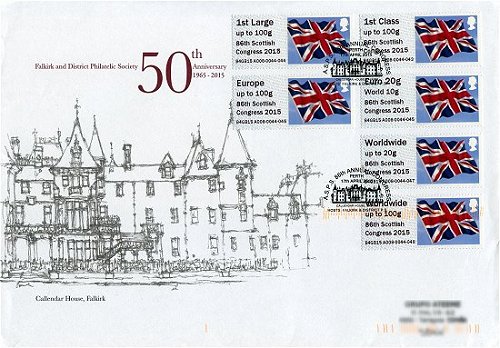 |
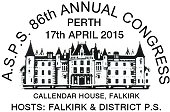 |
The British Postal Museum & Archive
commemorates the 175th anniversary of the Penny Black |
Earliest forerunner of the current 'Post & Go' stamps, the Penny Black was the world's first adhesive postage stamp.
In 1837, at the initiative of Sir Rowland Hill, the British government undertook a major reform of its postal system, simplifying the complex postal rates and introducing the stamp as a postage prepaid indicator. Until then, the recipient paid postage on delivery, according to the distance the item had travelled. After the reform, the sender would pay the postal rate, according to weight and regardless of distance.
The Penny Black features the portrait of Queen Victoria on a background printed in black ink, and the face value was one penny, the current postal rate for an inland letter up to half an ounce (14 g.). Although it was issued on May 1st 1840, it was valid for postal use from May 6th. |
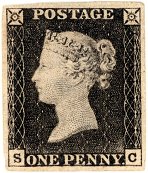 |
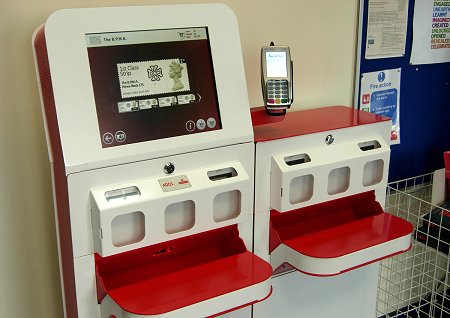 |
To commemorate the 175th anniversary of the introduction of the Penny Black, The British Postal Museum & Archive (BPMA) organized an exhibition and displayed the only full sheet of this stamp.
From May 6th 2015, its philatelic kiosk was programmed with a new commemorative text,
The B.P.M.A.
Penny Black 175
Next to the text, a new graphic design features the Maltese Cross, the first cancellation, created to prevent the re-use of the stamps. |
 |
The iconic design of this first postmark is also depicted in one of the commemorative cancellations created for the 175th anniversary of the Penny Black. |
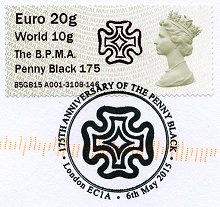 |
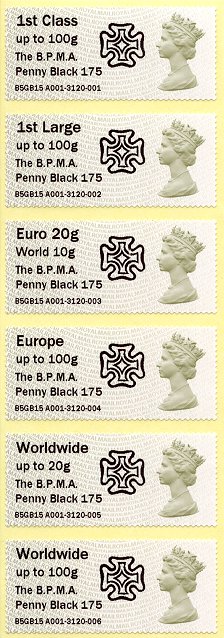 |
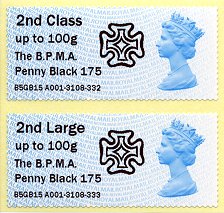 |
On the date of issue, the kiosk installed in The B.P.M.A. used three rolls of postage labels, with the definitive designs, 'Machin' for 1st and 2nd Class, and 'Union flag'.
The special imprint was only available on the two 'Machin' designs.
The 'Union flag' design has a free space of only 25 mm., at the left side of the design (in comparison to the 40 mm. in the 'Machin' designs), which does not allow for the graphic impression. |
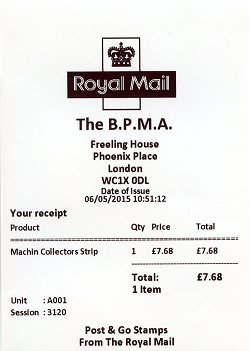 |
Curiously, on the first day of issue, the museum had a reduced stock of 'Machin 1st Class' postage labels, which were sold out within three hours.
This special imprint was available for three months, until August 7th. Various rolls of 'Machin' labels with different reprintings were used throughout the issue. |
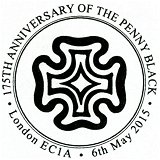 |
The B.P.M.A. sold a special folder or 'presentation pack', with the two 'collectors strips' plus a postcard, and two illustrated covers.
The first day cover (right image), features an illustration of Sir Rowland Hill and includes two ATMs and the museum postmark. The total print run was 400 copies.
The cover below was produced one week later, on the occasion of the participation of the museum in Europhilex 2015. The cover features a Mulready cover sent to Malta. The run was limited to 300. |
 |
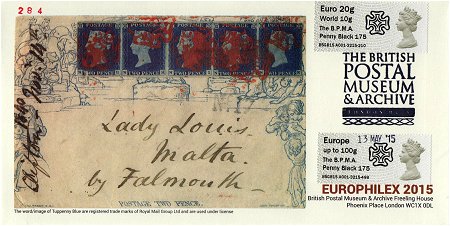 |
| In July 2015, apparently after a major remote upgrade of the kiosk, there was an important software error whereby the graphic design with the Maltese Cross was replaced by another graphic, similar to the design printed, in August 2014, to mark the 80th anniversary of inland airmail (see article, also published in VARIABLE 34). Possibly,
it was a preliminary design, which was never used at that time, but it had been kept in the system and, incomprehensibly, 'patched' into the machine software after the upgrade, on the evening of July 7th. This error appeared in all the stamps issued over the next 24 hours, until the morning of July 9th. |
 |
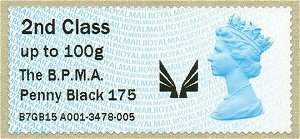 |
| Apparently, a very limited number of ATMs with this variety were issued (? ...), and it has become one of the most prized errors. At a recent auction, two 'Collectors Strips' with this error (upper images, taken from Ebay) were sold for just over 500 pounds (about 700 EUR) - an amount much higher than the current value of many 'Penny Blacks' ! ... Another source of outrage for most collectors, and -unfortunately- the source of encouragement for opportunistic treasures hunters. |
If that was not enough, after the reintroduction of the previous graphic design, and until the end of the issue, on August 7th, the Maltese Cross graphic was printed in a slightly different position, having moved to the right and downwards relative to its original position.
| 'Post & Go' at the 25th Essen stamps fair, in Germany |
At the beginning of 2015 Royal Mail announced a programme of nine philatelic events to be held during the year, with participation from its 'Post & Go Services'. Of these, five were held in the United Kingdom (86th Scottish Congress, Midpex, the two Stampexs, and Europhilex 2015), with the remaining four being held at major international fairs and exhibitions. Three of the philatelic fairs were in Europe -Essen, Sindelfingen and Paris-, and Singpex 2015, in Singapore.
The first appearance of the 'Post & Go' equipment in mainland Europe was at the 25th Internationale Briefmarken-Messe, the Essen stamps fair, in Germany. With over 30 postal administrations, 80 commercial stands, plus many study groups attending the event, it is one of the main annual philatelic fairs held in this country.
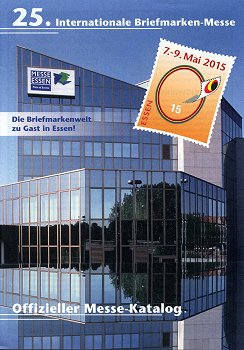 |
The stamp fair was held from May 7th to 9th 2015, in one of the halls of Messe Essen, one of the largest trade fair venues in Germany. |
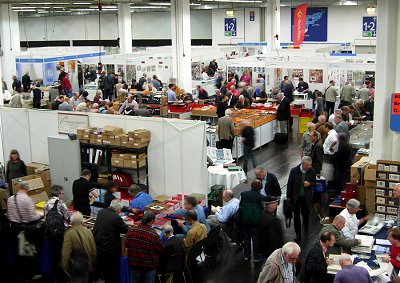 |
Apparently, it did not seem that the railway strike on those days had affected the number of visitors. During the first day, thousands of collectors attended the event. One of the most crowded places was the large Deutsche Post stand (images below), which took advantage of the presence of the 'Post & Go' equipment to install two of its Sielaff postal kiosks (right). However, both machines issued the two definitive designs ‘Brandenburg Gate’ and ‘Post Tower’, which had been on sale since October 2008 (see article, also published in VARIABLE 11).
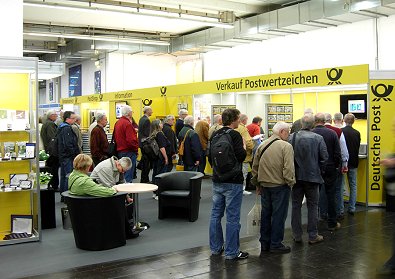 |
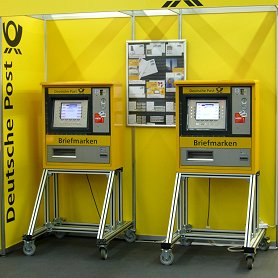 |
 |
In front of the German Post stand was that of the United Kingdom, with a display of its philatelic issues, and the 'Post & Go Services'.
Royal Mail installed two machines, in Essen. The kiosk labelled A006 of Royal Mail and, for the first time after its introduction at Spring Stampex 2015, the GG01 kiosk of Guernsey Post. |
| The presence of this innovative equipment and its special temporary issues aroused the curiosity and interest of many visitors. Fortunately, the easy-to-understand purchasing process and the extremely fast printing of the strips of stamps significantly reduced both waiting times and the usual queues. |
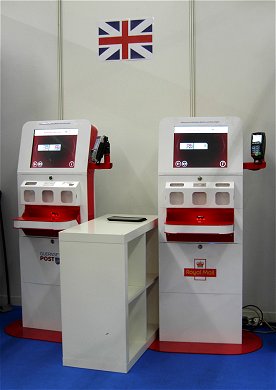 |
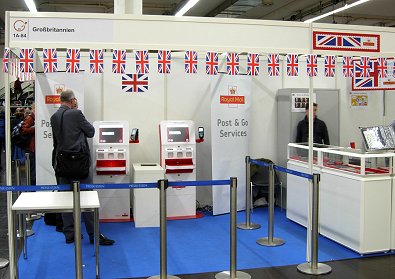 |
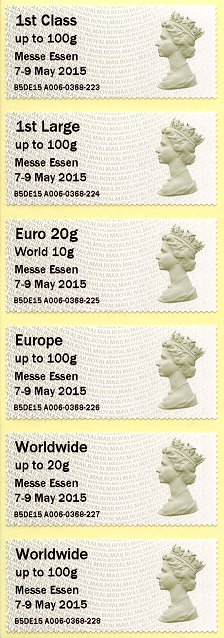 |
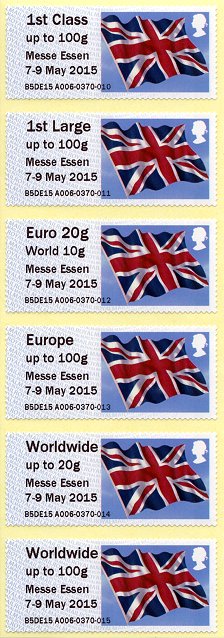 |
Royal Mail programmed a special text into the two postal kiosks in service, related to the philatelic event.
Over the three days, postal kiosk A006 issued ATMs with the 'Machin' (2013 reprint), and 'Union flag' (original design) definitive designs, and the special imprint
Messe Essen
7-9 May 2015
Since the issue was released in Germany, the code at the bottom of the stamps, issued during the stamp fair, is B5DE15 A006-.
Curiously, many of the ATMs issued with the 'Union flag' design, during the morning of the first day, have the impression shifted to the right (depicted).
Meanwhile, the GG01 postal kiosk of Guernsey Post (images below) issued stamps with the 'Jersey flag' and 'Union flag' definitive designs, with the same special imprint. In this case, the code at the bottom is B5DE15 GG01-.
(These issues are dealt with in more detail in the article dedicated to Guernsey Post). |
| Right, receipt for the purchase of the six programmed values set, or 'Collectors Strip', kiosk A006 |
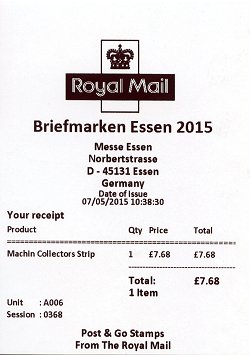 |
 |
| As usual, Royal Mail did not prepare any special postmark for these issues, nor did it set up any letter box where clients could mail covers franked with UK stamps. However, collectors could include a commemorative postal mark with their philatelic items. |
 |
 |
| 'Post & Go' issues commemorates the 70th anniversary of V.E. Day |
Friday May 8th 2015 was the 70th anniversary of V.E. Day, or Victory in Europe Day, the date on which the Allies in world war II accepted the unconditional surrender of Nazi Germany, marking the end of the war in Europe.
Royal Mail decided to mark this anniversary with the introduction of the temporary special imprint 'V.E. Day 70' in the three Intelligent AR kiosks installed in The National Museum of the Royal Navy, The Royal Marines Museum & The Fleet Air Arm Museum.
This impression was available from the three machines for three weeks, from May 8th to 29th, and only on the stamps issued with the 'Union flag' definitive design. |
 |
| On May 8th 1945, when the news that the war with Germany was over, celebrations erupted throughout the world. In London, a large crowd gathered in Trafalgar Square and in front of Buckingham Palace, where King George VI appeared next to the royal family along with the Prime Minister, Winston Churchill. |
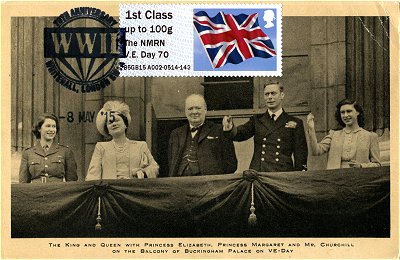 |
 |
Variable date commemorative postmark featuring the 70th anniversary of the end of second world war. |
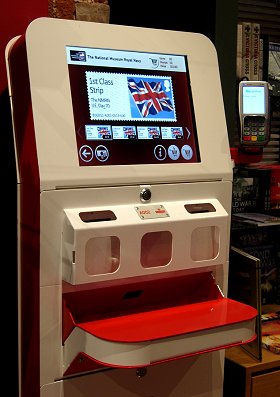 |
The National Museum of the Royal Navy (The NMRN), Portsmouth
Since the end of April 2015, the A002 kiosk has been re-installed in the southern museum shop, after refurbishment of the exhibition and sales spaces. |
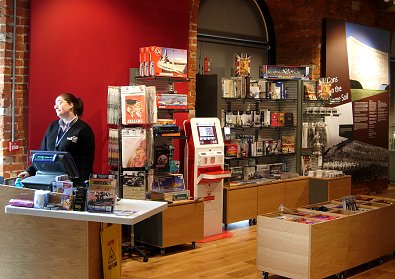 |
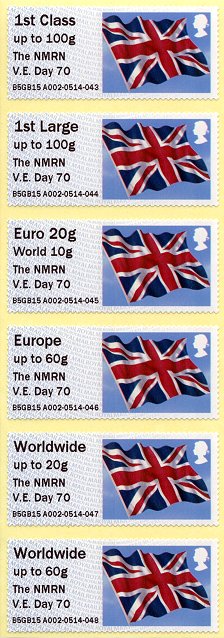 |
 |
During the morning of the first day of issue, visitors were surprised to find that the machine had been erroneously programmed with the two obsolete values 'Europe up to 60g' and 'Worldwide up to 60g' (first strip and left receipt, below), which had been valid until the last change of postal rates, on March
30th (see article).
After reporting it to the maintenance staff, the current rates became available at the kiosk from early in the afternoon (second strip and the right receipt). |
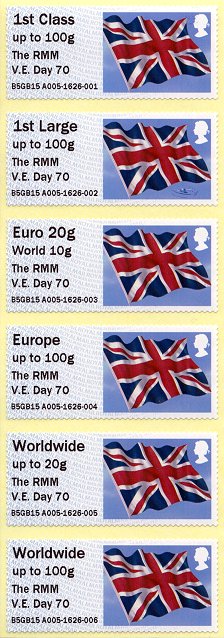 |
 |
The Royal Marines Museum (The RMM), Southsea
The museum shop had also been refurbished since the installation of the A005 kiosk, in January 2015. |
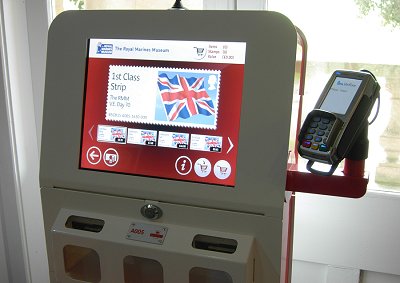 |
 |
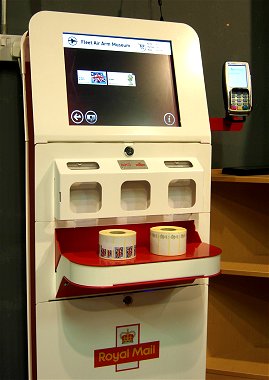 |
The Fleet Air Arm Museum (The FAAM), Ilchester
Royal Mail planned that the special text programming on the ATMs issued with the 'Union Flag' design, just three weeks after the installation of the A003 kiosk, had to be accompanied by the introduction of a graphic design with the museum’s logo on stamps issued with the 'Machin' design, although this last modification was again postponed. |
 |
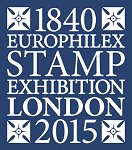 |
London's Europhilex 2015 was not just another international philatelic exhibition. Europhilex was the largest philatelic exhibition held in Europe since 2010, since the memorable London 2010 Festival of Stamps.
The first philatelic exhibition held in London dates back to 1890. Over these 125 years, the city has hosted many major philatelic exhibitions and fairs, 50 of them of international stature and, today, London can be considered the European capital of philately.
Europhilex was held from Wednesday 13th to Saturday 16th of May 2015, at the usual location of Stampex, the Business Design Centre in Islington. |
In this case, given the large scale of the event, the organizers installed the huge competitive international philatelic exhibition, with over 1400 frames, in various adjacent halls. The Club of Monte-Carlo organized a special display entitled 'Philatelic events that changed the world', a twenty frames exhibit featuring some rare and significant documents and philatelic items.
The magnificent central hall (right image) was fully booked for the stamp fair, with about 150 booths of dealers, auctioneers and postal administrations, as well as a reading room, society tables and various displays. |
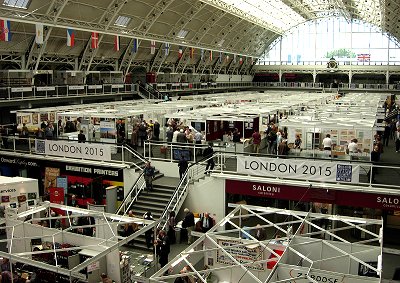 |
The organization expected more than 20,000 visitors over the four days. The first day, with tickets at 10 pounds, it was attended by far fewer visitors than expected, and some stand holders complained about the high cost of the booths and the lack of customers.
| The large Royal Mail stand was in a prominent position, on the 'Village Green', at the front of the hall and next to the exhibition entrance (pictures). On the left, the philatelic products exhibition and sales area. On the right, the 'Post & Go Services', with six (!) Intelligent AR philatelic kiosks in service. |
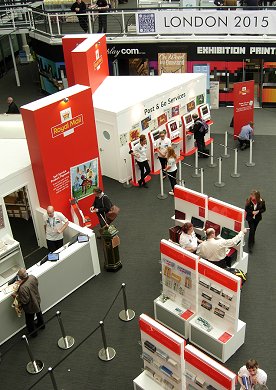 |
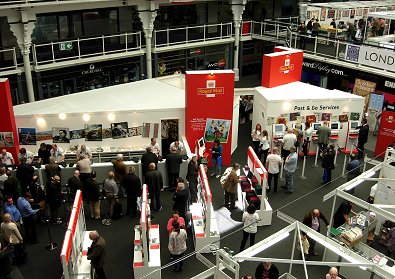 |
| Europhilex 2015 also celebrated the 175th Anniversary of the introduction of the Penny Black, the first adhesive postage stamp in history. |
| Among many other exhibition memorabilia, Royal Mail released a special overprinted ‘175th Anniversary of the Penny Black’ miniature sheet in a special presentation pack. Limited to a production run of 7,500 and with a daily and per customer allocation, the sale of the pack caused long queues of collectors at the start of the day, which were in addition to the usual queues at the Royal Mail stand. |
 |
 |
The evolution of the 'Post & Go Services' in recent years has been spectacular. We can remember the first Wincor Nixdorf self-service postal kiosk installed, on a trial, at the London 2010 Festival of Stamps, which was issuing stamps with the definitive designs and just the special code 002010 0. In the Europhilex 2015, there were six philatelic kiosks, and the ‘Post & Go’ countries releases regular thematic series plus temporary special imprints on the occasion of the major philatelic and social events ... |
After the Jersey and Guernsey postal administrations, new for Europhilex 2015 was the arrival of Gibraltar to the growing 'Post & Go' family.
In the picture, from left to right are, the Royal Mail A006 and A008 kiosks, the JE01 unit of Jersey Post, GG01 of Guernsey Post, and the new GI01 of the Royal Gibraltar Post Office. |
 |
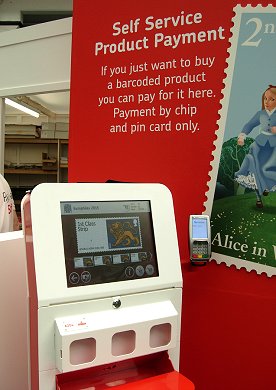 |
Next to the sales counter, Royal Mail installed a sixth kiosk, A004. Visitors could use the machine not only to print the 'Post & Go' issues, but also for the self-payment of the various bar-coded philatelic products displayed on the stand. |
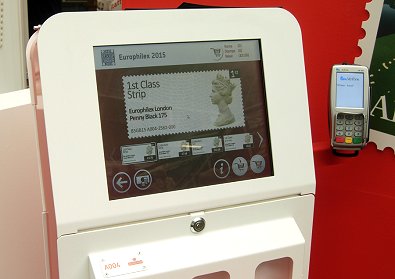 |
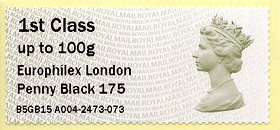 |
During the four days of Europhilex 2015, the Royal Mail A004 and A006 kiosks issued ATMs with the Machin definitive design (original and 2013 reprint) and the special imprint
Europhilex London
Penny Black 175
on one of the reels, and the new 'Heraldic Beasts' series in the other (see next section).
Receipts issued by the A006 machine, during the morning of the first day of issue (May 13th) have the wrong date of May 10th. |
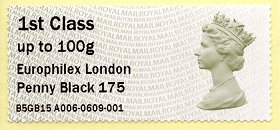 |
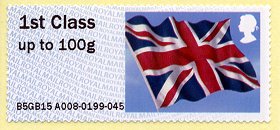 |
The A008 kiosk issued stamps with the Union flag definitive design (original printing), with no special imprint, and the new 'Heraldic Beasts' series.
The first block of the code at the bottom of all the ATMs, issued during Europhilex 2015, is B5GB15, followed by the machine code, transaction and stamp number. |
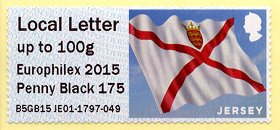 |
The Jersey Post JE01 kiosk issued ATMs with the Jersey flag definitive design and the special imprint
Europhilex 2015
Penny Black 175
on one of the reels,
and the thematic 'Protected species' series with no special imprint in the other.
The stamps issued by this machine were sold with a 20% surcharge on the face value, because of the VAT on sales made by Jersey Post in the UK.
These issues are dealt with in more detail in the article dedicated to Jersey Post. |
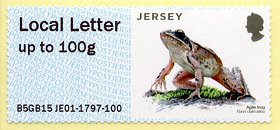 |
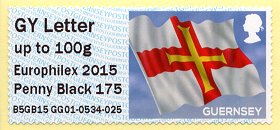 |
The Guernsey Post GG01 kiosk issued ATMs with the Guernsey flag definitive design and the special imprint
Europhilex 2015
Penny Black 175
on one of the reels, and the UK Union flag design, with no special imprint, in the other printer.
Just like the Jersey kiosk, the stamps issued by this equipment were also sold with a 20% surcharge on the face value.
These issues are dealt with in more detail in the article dedicated to Guernsey Post. |
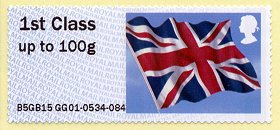 |
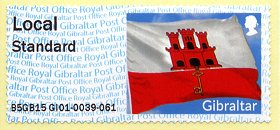 |
Finally, the brand new Royal Gibraltar Post Office GI01 kiosk issued ATMs with the new Gibraltar flag definitive design on one of the reels, and the UK Union flag design on the other, both with no special imprint.
During most of the first day of issue, one of the values programmed with the Gibraltar flag was printed with the error 'Wordwide up to 20g', instead of 'Worldwide up to 20g'.
These issues are dealt with in more detail in the article dedicated to Royal Gibraltar Post Office (in preparation). |
 |
In addition to these machines, large pre-orders were printed by using the internal usage printers B001 (UK designs) and B002 (Jersey, Guernsey and Gibraltar designs, sold by their respective philatelic services).
Jersey Post & Guernsey Post shared a stand in Europhilex (image below). |
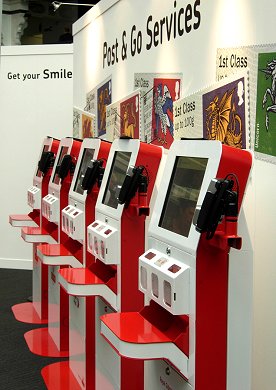 |
 |
As in the London 2010 exhibition, the Post Office set up a temporary post office in the upper gallery, offering a limited range of common operations found in post offices.
Especially interesting in our field of study, is the equipment installed in the office issued variable value stamps or 'Horizon labels' with a new design (right), announced since mid-2014, but not yet used at post offices.
The post office also had two special postmarks, one of them with a large size (46 mm.) and exhibition commemorative text. |
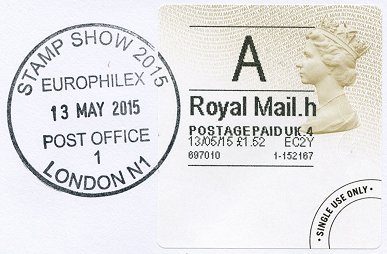 |
New for Europhilex, Royal Mail arranged a booth where visitors could see, in operation, one of the machines normally used for philatelic items special cancellations, and obtain the exhibition commemorative postmarks.
In the UK, unlike most countries, special postmarks are never available at the philatelic events themselves. It is necessary to send or deliver letters and other philatelic items to the corresponding Special Handstamp Centre. |
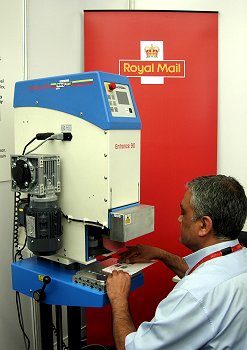 |
 |
 |
The second 'Post & Go' thematic series, in 2015, features six creatures appearing on the older British coat of arms and heraldic badges over nearly 900 years. The set was available from May 13th 2015, coinciding with the opening of London 2015 Europhilex.
On the date of issue, the new series could be obtained at many of the NCR postal kiosks installed in post offices across the country, and also from the Intelligent AR postal kiosks (A004, A006 & A008), installed at London Europhilex. The large pre-orders were printed using internal-use equipment, with the code B001.
Royal Mail released its usual presentation pack with the six designs (right image), printed by the internal-use C002 printer. |
 |
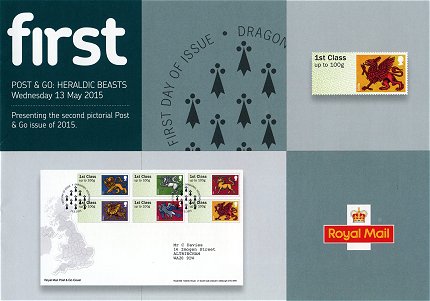 |
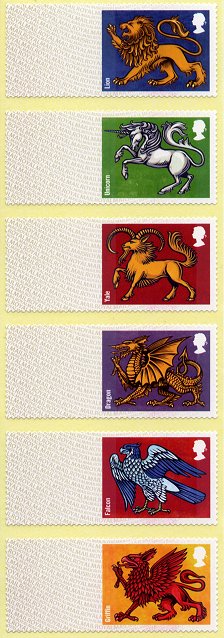 |
The six illustrations were created by Chris Wormell, and feature the lion, unicorn, yale, dragon, falcon and griffin.
The rolls of labels were manufactured by International Security Printers, and have identical characteristics to previous issues. The design is by Osborne Ross. |
 |
| |
 |
 |
| |
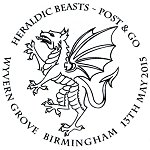 |
 |
| Pictorial first day of issue postmarks |
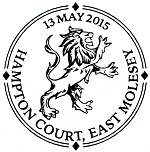 |
 |
| Chris Wormell, the author of the illustrations, in Europhilex 2015 |
 |
 |
The images below show ATM strips with the different printing varieties and the six face value indicators available for this set of designs, issued by the equipment used on the date of issue. From left to right,
(1) the C002 printer, used for advance printing of the stamps included in the presentation packs,
(2) the Intelligent AR equipment (A004, A006 & A008), in service at Europhilex, and B001 for internal use,
(3) the NCR postal kiosks.
All the ATMs included in the folders have the same face value '1st Class up to 100g', and the lower identification code is the same for all the stamps - In this case, B5GB15 C002-1840-019. In the first block, B is for 'philatelic' issue, 5 is for the month of issue (May), GB for the country, and 15 for the year of issue. In the second block, C002 is the code of the printer. Then follows 1840, the usual fictitious session number (using the year of issue of the Penny Black), and 019 indicates the number of the pictorial series, since the beginning of the 'Post & Go' issues. |
 |
| First day of issue receipt for the purchase of one 'Collectors strip', the set with the six values programmed, in the A008 Intelligent AR postal kiosk |
Printer
C002 |
Intelligent AR
A004 - A006 - A008 - B001 |
NCR
postal kiosks |
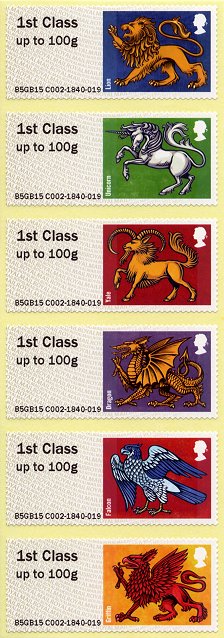 |
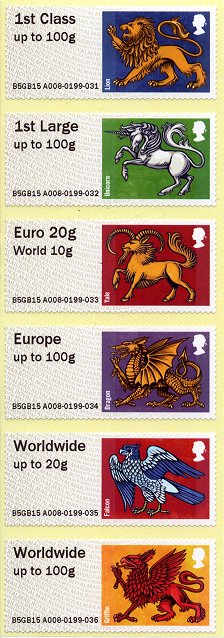 |
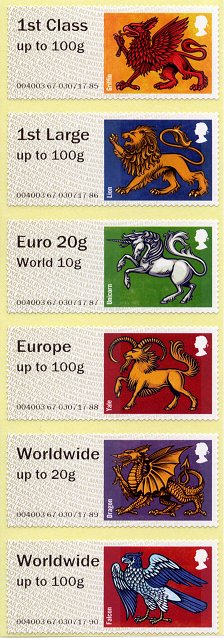 |
| The 'Open value stamps' can be obtained from the NCR postal kiosks only, by selecting the 'Post an item' option from the main menu. These are variable value stamps, usually printed for immediate use, and include some details about the shipment type, postage rate, destination and weight of the item (see article, also published in VARIABLE 34).
The six 'open value stamps' on the images correspond to the six face value indicators programmed in the 'Collectors strip'. |
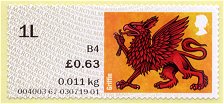 |
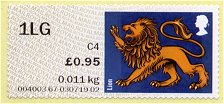 |
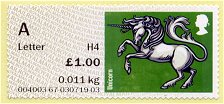 |
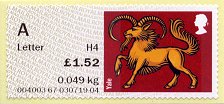 |
 |
 |
ATM Web - Spain and Latin American Postal Services: http://www.ateeme.net
© J. Jove - ATEEME. Variable value stamps study group. All rights reserved
This page was created in February 2015 and last updated:
06.09.15
. English edition last rewritten by S. Goodman (19.08.2015)
|








